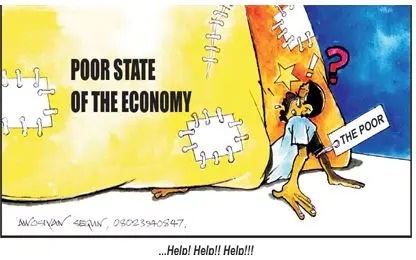
THE Vanguard on Thursday August 25, 2022 carried a minor headline, ”Nigeria’s economy on the verge of collapse – SANUSI”. Muhammad Sanusi is an economist, a former Governor of the Central Bank of Nigeria and Ex- Emir of Kano. He raised the alarm about the state of the Nigerian economy in the interview he granted Gabriel Olawale of the Vanguard newspapers during the 10th year memorial lecture in honour of the founder of St Nicholas Hospital, the late Dr. Moses Majekodunmi, in Lagos. He raised the alarm, noting that all indications had shown that the nation was not on the part to greatness.
I agree with Muhammad Sanusi that the Nigerian economy is on the verge of collapse, but I do not agree with him as to the causes and the remedies for the dangerous state of the economy. He said 2023 was not about Muslim-Muslim ticket and Emi lo kan. He also lamented government borrowing to pay subsidy and decried the low intellectual quality that characterises Nigeria’s political discourse in view of the many intellectuals in the nation.
I place all the blame on the shoulder of the economists, home and abroad, who have been planning the development of Nigeria since independence. Economists here include all economists and all other Western social scientists, related specialists like accountants, bankers, administrators, lawyers, etc., who lack the intellectual capabilities to analyse the claims of economics/economists and take them as axiomatic truths.
We have carried out a 36-year curiosity-driven research aimed at understanding the scientific basis of the present global distribution of wealth and power and how nations develop. Our effort has been blessed abundantly. We have so far summarised the highlights of our results in an eight-book series.
We found out that economics as a discipline has many debilities which make it unsuitable as the intellectual premise for planning the development of a nation. Two of the debilities are particularly incapacitating. First, economics/economists lack a sense of history. Second, economics and economists lack the understanding of the science which underlies the human development process. No one solves a problem s/he does not understand. These are the two major reasons economists cannot manage any economy well. The consequences of these two debilities are many.
History shows that all the rich nations of the world were low-productivity, poor agricultural/artisan nations for many centuries before they achieved the modern industrial revolution, IR, and became rich. Theory: IR or industrialisation is the solution to poverty and the associated problems. Economics/economists do not know this important historical fact. If they know this historical fact, they do not apply it.
Consequently, they make claims about the human development process which portray the process as if it were a once-for-all competition like a football match played long ago in which the industrialised nations won and the poor nations lost. They are wrong because the modern industrialisation took the rich European and Asian nations 2000-3000 years. It is not a competition among nations and it is not a once-for-all process.
Because the achievement of the modern industrialisation is the solution to poverty, all poor nations ought to plan and endeavour to achieve it. Sadly, for lack of a sense of history and lack of understanding of the science that underlies the human development process, economists cannot plan for or emphasize industrialisation.
The nation’s economists plan for their development can only mope and drift. Nigeria has been moping for over 60 years. It is because economists do not understand the science that underlies achieving sustainable economic growth, industrialisation and development, SEGID, that they measure GDP growth. Yet, for the poor nations to make progress, they must focus on promoting SEGID.
How should a nation promote SEGID? All economists are Marxians. That is, all economist believe that capital investment is the primary basis for achieving SEGI, sustainable economic growth and industrialisation. To all economists, once capital is invested, growth ensues. What type of growth? GDP growth? GDP growth is trivial because a nation may achieve a 7% GDP-growth one year and go into negative growth the following year.
The Jonathan administration was boastful of attaining 7% GDP and being the second fastest growing nation in the world. Immediately the Buhari administration started in 2015, the Nigerian economy went into recession. Poor nations which depend on the sale of commodities often experience this.
These are the reasons Nigeria and other African and Latin-American nations have been moping and drifting over the decades. Economists’ claim about capital investment has been proved wrong by many economists and non-economists. Economists do not know the primary source of SEGI. How can economists manage an economy well? Many economists know that economics and economists do not understand how an agricultural/artisan economy can be transformed into an industrialised economy.
Ogbimi (2003) demonstrated that mere capital investments do not promote Competence-Building-Growth/
Learning (education, training, employment and research) is the primary source of promoting SEGI. Education, alone, co-exists with mass unemployment and poverty. That is the experience of African and Latin America and the Caribbean nations. The learning people are Appreciating Assets, AAs, because the intrinsic values of the learning people appreciate with learning time and intensity.
Learning results in relatively permanent changes in knowledge, skills, experience and other behaviours (Klausmeier, 1985). Also, learning progresses from the novice’s position to the expert’s position (Stahl, 1990). A nation which emphasizes learning invests in increasing investment function. Hence, the growth of the intrinsic value of the learning people may be modelled by the compound interest formula.
A nation’s competence to do many things increases as long as the citizens continue to learn. The economic transformation described as Industrial Revolution, IR, is reached after many millions of people have learnt sufficiently and the nation has accumulated a critical amount of knowledge, skills and capabilities, KSCs.
It may be likened to the transformation which the spider achieves when it combines many of its silk-threads to make its web. The single silk-thread which the spider spins is a relatively weak structural material which fails readily under any stress regime. However, the web, which is made from the combination of many of the weak silk-threads – the economy, catches the small creatures on which the spider feeds. In a like manner, no individual solves the problems of a nation, but a combination of many millions of knowledgeable, skilled and competent people transforms an agricultural nation into an industrialised one.
Our quantitative analyses showed that the five variables for planning for industrialisation are: 1) Ni – the number of people involved in productive work or employment in a nation; 2) Moj- the level of education/training of those involved in productive activities in the economy and of the people of the nation; 3) Lk – the linkages among the knowledge, skills, competences and sectors of an economy; 4) rl – the learning rates or intensity in the economy and especially among the workforce; and 5) np – the experience of the workforce and the learning history of the society.
All the variables are related to the learning-man and learning-woman. Moreover, the higher are the values of the variables, the better is the economy. A national growth rate measurement based on some or all of these variables would reflect the true economic situation in the nation. A nation achieves industrial revolution when these variables attain critical values.
(Vanguard)








676475 529910Yeah bookmaking this wasnt a speculative decision outstanding post! . 430011